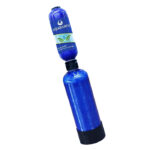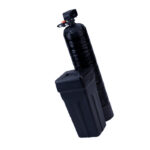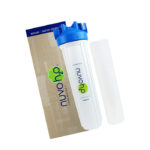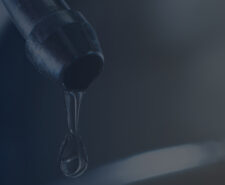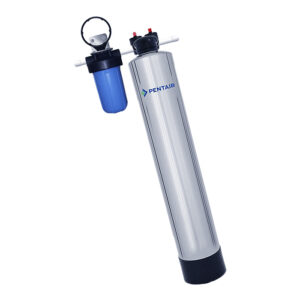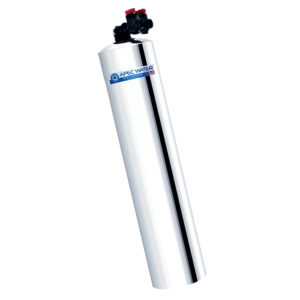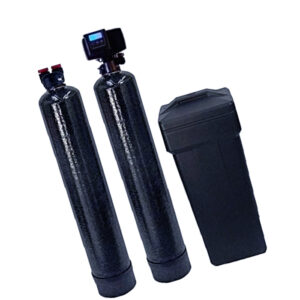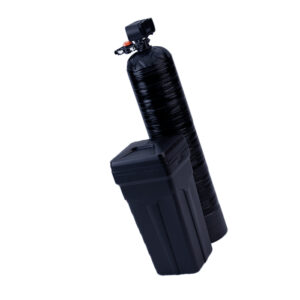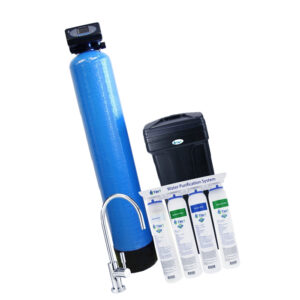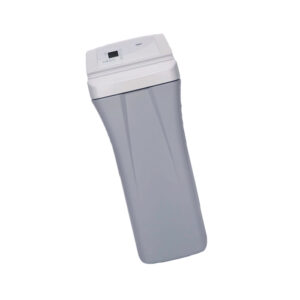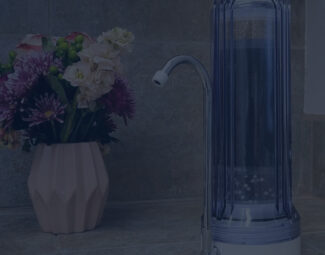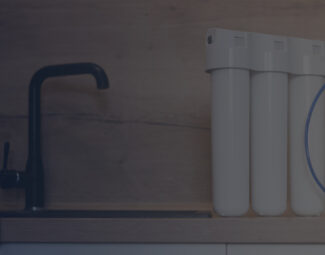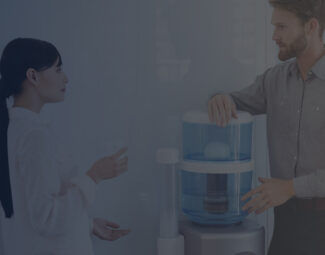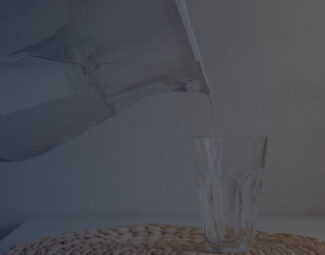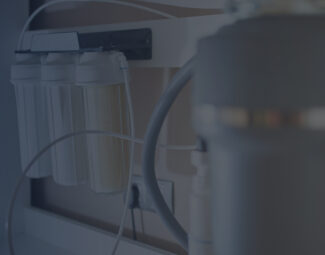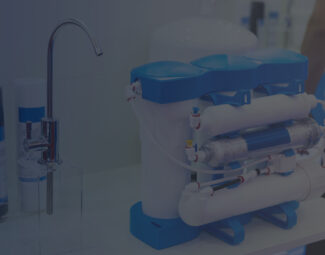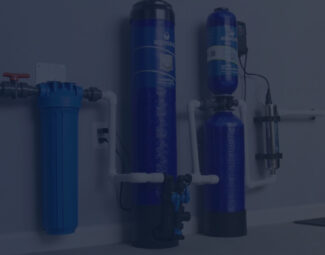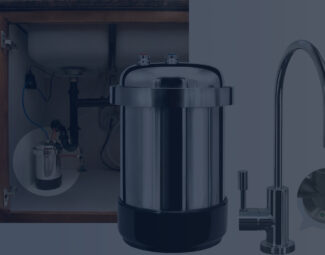1. Aquasana SimplySoft Salt-Free
Check Price at Amazon
Summary: For those who have ever had contact with the world of water filtration systems, Aquanasa is a brand that needs no introduction since it is what most consider to be the best in the business. Aside from producing top-of-the-line water filters, it is the company we have to thank for the best water softener too. The Salt-free system we review here is worth every cent since it provides an Eco-friendly manner to reduce water hardness, it’s easy to set up, and there’s not much maintenance work you have to do either.
Click here to see what other water filters and softeners the Aquasana company has to offer!
Pros:
- Since it is a salt-free system, drinking the water it passes the softening process through is safe for consumption even for people who have dietary restrictions when it comes to sodium intake
- Since it doesn’t require backwashing, maintenance work is minimal with this Aquasana system
- Water pressure is not affected by this softening system
- You can check at a glance when pre-filter replacement is due since a simple color change shows that the upkeep task is needed
Scale reduction efficiency
Water pressure after installation
If you have ever explored the market for water filtration products, a brand that you surely stumbled upon is Aquasana, a company that many, including us, view as the most serious manufacturer in this domain. Using the latest technologies so that it proves indispensable in households where hardness causes issues, the
salt-free system is hands-down the best selection to go for.
Balancing the fantastic results and 6-year longevity with the asking price, it’s safe to say it is a bargain that anyone would be lucky to benefit from using. A clearance of 27 inches is needed to install it, and the tank measures 46 inches H and 9 inches D. Furthermore, the setup process is an easy one that you are sure to be able to handle on your own if you have minimal experience in handy work.
SCM Technology
The SCM technology inhibits scale buildup and turns dissolved minerals into microscopic-size crystal particles that harmlessly pass through the water and go down the drain. This method is more beneficial than you could imagine as it provides conditioning so that it won’t contaminate the water with high amounts of sodium.
Mention Worthy Features and Specs
- Output between refills of approximately 600,000 gallons.
- Maximum hardness removal of 25 GPM.
- The full installation kit is included.
Maintenance
- For the pre-filter – At first, the pre-filter is white. To make maintenance an easy task, you can perform a visual check every month to see if the color has changed. When it does, it means that cartridge replacement is needed so that you avoid clogging and fluctuations in water flow.
- For the descaler – It is rated to last approximately 6 years, so when this period passes you ought to change it altogether.
Benefits
- Protection from scale buildup and extends the lifespan of certain household appliances;
- Safer for irrigating plants;
- Doesn’t pollute the water supply;
- Your skin won’t feel slimy anymore;
If skin beauty is important for you, then consider drinking alkaline water that a water ionizer provides on demand. This high-pH water is much more hydrating than its classic counterpart, which results in healthier-looking and feeling skin, among other perks.
- Drinking water won’t contain sodium after you start using it;
- Does not produce water waste.
Warranty
We start by mentioning it can be returned in case it doesn’t live up to your standards. Yes, Aquasana gives you the possibility to return it within 90 days of acquiring the system, refunding the full purchase price as long as you have not deteriorated it.
When it comes to backing, the company covers it for 6 years against faults in materials or workmanship in manufacturing. However, we advise you to read the warranty agreement as there are circumstances in which you can cancel it or situations that aren’t covered, which means that you won’t benefit from free repairs if those situations emerge.
Performance Test Feedback
We installed the Aquasana Salt-Free water conditioner following the instructions in the manual and we didn’t encounter any issues during the setup procedure. It took just a few hours and didn’t require any extensive plumbing knowledge, which has convinced us to recommend DIY installation to our readers too if you have the time and trust yourself with the task. Since it doesn’t use salt in the softening process, we didn’t notice any change in taste after installing it. However, what it did change was what interested us most – hardness levels. We did two basic tests to check hardness levels. Before setting up the Aquasana system, we filled a bottle one-third with tap water, added a few basic liquid soap drops in it, and shook the bottle for a few seconds. It was obvious that the water is hard since there weren’t many bubbles formed and the water looked cloudy. The test we did after installing the water softener provided different results, however. After shaking the water-soap mixture, a lot more bubbles formed, and the water looked very clear, indicating that the water is soft. We were pleased by the fact that the pressure with which water poured from the taps didn’t change either, even when we turned on the shower, kitchen faucet, dishwasher, and washing machine.
Marcus Mackay – Expert Tester and Reviewer
Aquasana SimplySoft Salt-Free Specifications Sheet
|
| Type: Salt-free |
Media Replacement: After filtering 600,000 gallons |
| Maximum Hardness Removal: 25 GPG |
Flow Rate: 7 GPM |
| Technology: SCM
|
Maximum Working Pressure: 100 PSI |
| Maximum Working Temperature: 90°F |
Wasted Water: |
| Retention of Beneficial Minerals: |
Warranty: 6 years |
2. Pelican NaturSoft Salt-Free NS6
Check Price at Amazon
Summary: Our runner-up, produced by a brand that, just like Aquasana, has already made quite a name for itself, the Pelican water softener is another salt-free system that you can count on to reduce hardness through a safer method. Instead, the water is naturally treated, and the results are quite impressive. Installing it isn’t much of a hassle either, so there’s no downside to making this acquisition.
Click here to see what other water filters and softeners the Pelican company has to offer!
Pros:
- Certified to prevent scale build-up by up to 99.6%
- Does not use salt
- Zero water waste and no energy consumption
- The slimy feeling after showers/baths won’t exist anymore
- Can be installed in homes with 4-6 bathrooms
Scale reduction efficiency
Water pressure after installation
Providing naturally softened water through a friendly process that doesn’t involve the use of salt, the Pelican entry was an inevitable pick. Are you wondering how it works? Well, let us explain it in short.
The media has calcium carbonate crystal structures on the surface that have the role of attracting the excess dissolved hardness and removing it through integration with the aforementioned structures.
It is 100% Eco-friendly because it doesn’t produce any water waste, and it doesn’t draw on electricity to run either, which means that it adds $0 to the electricity bills to provide softened water. Maintenance-wise, you won’t have a lot of work on your hands as you just have to remember every 6 to 9 months to change the sediment filter.
The maximum hardness it can tackle is 1282 milligrams per liter, an aspect you must take into consideration as signs of it underperforming could indicate that your needs surpass its capabilities. Compatible with a maximum flow rate of 15 GPM, it is recommended for homes with 4 to 6 bathrooms. From this point of view, it surpasses the top-rated Aquasana SimplySoft since it flaunts a flow rate a bit more than double as large.
In the package, aside from the system and the pre-filter are included the mounting hardware of the pre-filter system, as well as the bypass valve and 1” fittings. There is an installation manual included that provides the info you need to get through the installation without any hiccups along the way.
Pelican NaturSoft Salt-Free NS6 Specifications Sheet
|
| Type: Salt-free |
Media Replacement: NS6 media doesn’t require replacement, sediment pre-filter needs to be replaced every 6-9 months |
| Maximum Hardness Removal: 75 GPG |
Flow Rate: 15 GPM |
| Technology: NaturSoft media
|
Maximum Working Pressure: 80 PSI |
| Maximum Working Temperature: 120°F |
Wasted Water: |
| Retention of Beneficial Minerals: |
Warranty: Lifetime |
3. Apec FUTURA-10
Check Price at Amazon
Summary: A recommended system for homes with 3 bathrooms tops, this APEC softener is a large capacity product that helps solve issues produced by scale since it won’t build up anymore. Just like the Aquasana SimplySoft and the Pelican NaturSoft, this is a salt-free softener, so one task you won’t ever be bothered by is backwashing. Moreover, it doesn’t affect water pressure either if you install it in an appropriately-sized house, so there are no negative changes after you finish setting it up.
Click here to see what other water filters and softeners the Apec company has to offer!
Pros:
- It provides an Eco-friendly manner to treat hardness as it doesn’t use salt
- Suitable for use in homes with 1-3 bathrooms
- Completely maintenance-free – no backwashing, salt replacement, or drainage
- The manufacturer backs it with a 10-year warranty and offers lifetime support
Cons:
- Asking price is a bit high
- Swapping the plumbing connections is a bit difficult
Scale reduction efficiency
Water pressure after installation
It provides an advanced, Eco-friendly technology that employs ceramic media to attract and neutralize hard water properties. It doesn’t use salt in the process, which means that
backwashing and regeneration aren’t aspects to worry about.
As the catalytic granules are used up during conversion, durability is guaranteed with the Apec system. It is easy to install, so if you are somewhat savvy in DIY tasks, you won’t have to spend money on expert installation. After you install it, the water won’t feel slimy anymore and will become ideal to clean dishes, windows, and hard water spots on the car. Take into account that it provides optimal performance when used for treating hardness levels of up to 25 grains per gallon.
The 10 GPM flow rate makes it suitable for use in houses with 1-3 bathrooms. It is covered for 10 years from the moment you acquire it so that you don’t have to spend money out of your pocket on repairs if anything happens during this period.
There’s even lifetime support provided by the company, so whenever you are tackling issues with the system, you will receive expert help immediately.
Apec FUTURA-10 Specifications Sheet
|
| Type: Salt-free |
Media Replacement: Every 3-5 years |
| Maximum Hardness Removal: 25 GPG |
Flow Rate: 10 GPM |
| Technology: Advanced ceramic media |
Maximum Working Pressure: N/A |
| Maximum Working Temperature: 120°F |
Wasted Water: |
| Retention of Beneficial Minerals: |
Warranty: 10 years |
4. PRO+AQUA 80,000 Grain Capacity Water Softener
Summary: This salt-based dual-tank softener uses powerful ion exchange resin to treat medium to high water hardness levels. As soon as you install it, you will notice changes in the way your hair and skin look and feel since damaging minerals and chemicals won’t bond to them anymore. Laundry will look better too, and all of your water-using appliances will receive a boost in their performance. Best of all, this is an 80,000-grain capacity model that needs far less in terms of maintenance compared to the other salt-based systems we reviewed.
Pros:
- Uses high-capacity resin to soften the water better than competing systems
- Designed to waste as little water as possible during the softening process
- 1-inch ports ensure proper water flow
- Works on city and well water – install it regardless of your water source
- Customer support staff are very helpful and prompt
Cons:
- Installation is a bit difficult since it requires you to connect the system to the water line and the drain, which implies small changes to the plumbing system
- It’s hard to tell if you program it right since the instructions are ambiguous
Scale reduction efficiency
Water pressure after installation
Of all salt-based water softeners, this PRO+AQUA product might just be the best. It’s
a dual-tank system that uses powerful ion exchange resin to treat medium to high water hardness levels, in turn helping your water-using appliances run better, protecting the piping system of your home, and helping your skin and hair look better while amping their health.
The 80,000-grain capacity is a perk on its own since it makes the system perfect for large households where water is extremely hard. This large capacity also makes it efficient to treat hardness levels of up to 110 GPG as long as the maximum number of users is 4 people. Although it’s a dedicated water softener, it can remove a small amount of iron from the water too, namely 2 ppm.
The high capacity combined with the 1-inch high-flow threaded ports assures of the fact that it allows fast water flow. Therefore, you won’t see any drops in water pressure regardless of how many taps are running simultaneously. To give you a better idea of how well it performs in large households, know that it puts out 12 gallons of soft water per minute. This makes it perfect for homes with multiple bathrooms, hands down.
The brine tank is very large, holding approximately 120 pounds of salt. For a family of 4, refilling the brine tank is needed once every 2 months or so. It doesn’t require regeneration as often as its competitors do, saving on water and salt usage due to this. Best of all, the programmable digital meter automates the regeneration process to make your effort toward upkeep as little as possible.
Before we end the review, we want to warn you about one thing – don’t install it yourself if you don’t have plumbing experience/knowledge. This system requires connection to the main water line and drain, so there are changes to be made to the plumbing system. For this reason, we recommend expert installation if you aren’t experienced. Other than this, we have nothing negative to say about the PRO+AQUA softener. It’s a softener that delivers reliable performance and promises little water and salt waste.
PRO+AQUA 80,000 Grain Capacity Water Softener Specifications Sheet
|
| Type: Salt-based |
Media Replacement: 80,000 grains |
| Maximum Hardness Removal: 110 GPG |
Flow Rate: 12 GPM |
| Technology: Salt system |
Maximum Working Pressure: 125 PSI |
| Maximum Working Temperature: 100°F |
Wasted Water: Minimal |
| Retention of Beneficial Minerals: |
Warranty: 5 years |
5. 3M Water Softener System 3MWTS100
Summary: The standout trait of this 3M water softener is that, unlike other salt-using systems of the sort, it doesn’t produce as much water waste in its operating process. To grant this perk, it monitors water use and employs regeneration only when needed. Water softening efforts are significantly superior to that of most units available, which is why it ranks so high despite the smaller capacity and higher asking price. After all, it’s the performance that matters most, and the 3M really knocks it out of the park when it comes to this particular aspect.
Pros:
- Regeneration cycle is optimized by assessing past use to conserve water, energy, and salt
- Efficient regeneration is guaranteed by the resin re-circulator that lifts the resin from the bottom to the top of the tank
- Features an ingenious salt shelf that traps dirt and debris, keeping them away from the brine draw area
- Solid tank design for long-lasting durability – made with high-density polyethylene and composite fiberglass
Cons:
- Lower grain capacity than cheaper models, like the Aquasure Harmony Series
- Suited for smaller homes, preferably with 2 bathrooms tops
Scale reduction efficiency
Water pressure after installation
Specialized in reducing scale and water hardness, the 3M 3MWTS100 is a salt-based system with a 28,100-grain capacity that you can count on to make a significant difference in water quality if you source your water from the well. What we like most is that
it reduces water usage by metering use and following through with the regeneration process only when necessary, saving you water, energy, and salt so that operational costs are minimized.
Another mention-worthy detail related to the regeneration process is that the resin re-circulator lifts the resin from the bottom of the tank to the top. As this happens, there is a scrubbing action that takes place between resin beads, resulting in a more efficient regeneration and extended media lifespan.
Unlike other systems, it doesn’t require much in the way of maintenance, especially considering that it features a multi-level salt shelf which serves the purpose of keeping dirt and debris away from the drawing area, resulting in reduced valve upkeep.
The system even shines in the durability department considering that the tank is solid due to the high-density polyethylene and composite fiberglass construction. The peak operating temperature it withstands is 100 degrees Fahrenheit, while the operating pressure ranges from 20 to 125 PSI. Lastly, we mention that the product is covered with a 5-year warranty for the valve body and electrics, and a 10-year warranty for the tanks (filter and salt brine).
3M Water Softener System 3MWTS100 Specifications Sheet
|
| Type: Salt-based |
Capacity: 28,100 grains |
| Maximum Hardness Removal: 7.9 GPG |
Flow Rate: 8.9 GPM |
| Technology: Salt system |
Maximum Working Pressure: 125 PSI |
| Maximum Working Temperature: 100°F |
Wasted Water: N/A |
| Retention of Beneficial Minerals: |
Warranty: 5 years for the electronics and valve body, 10 years for the filter tank and salt brine tank |
6. Discount Water Softeners Genesis Duo
Check Price at Amazon
Summary: This is one of the most sought-after salt-based softeners since it needs an insignificant amount of salt for the regeneration process and wastes little water too. The Genesis Du is a must-have if you are looking for a great deal not only when it comes to the asking price but running expenses as well.
Pros:
- Flushes stagnant water after a week to prevent bacteria growth
- Features upflow brining that calculates the exact amount of salt brine needed for the process to reduce salt use by up to 30% as opposed to competitive models
- Can hold up to 300 pounds of salt
- Regeneration wastes only 9 pounds of salt and 64.3 pounds of water
Cons:
- The valve is a bit flimsy, so make sure that you tighten it with care or it will crack
- Cabinet version is not available for this model
Scale reduction efficiency
Water pressure after installation
Recommended for large-sized households, this
48,000-grain capacity system uses salt to ensure scale buildup won’t happen ever again. It features a large-size brine tank that can hold a maximum of 300 pounds of salt, and tank tux jackets that reduce sweating to upkeep performance are included.
It relies on carbon to reduce chlorine, so if your municipality tends to abuse chlorine use to tackle bacteria and other harmful contents, it will deal with the chemical to solve issues related to the taste and odor it tends to leave. The only other water softener that competes with it when it comes to chlorine reduction is the ABCwaters 5600sxt, so if you’re looking for an alternative, this is the closest one performance-wise.
One of its biggest highlights is the up-flow brining that ensures an optimal amount of salt is used for the regeneration process to save on maintenance and operational costs. When a week passes since it hasn’t been used, the stagnant water is flushed automatically by the System Refresh to ensure that bacteria won’t grow in it.
The recharge mode, one of its most useful features, guarantees that in times of need when heavy water usage is due, you will be provided with soft water. On the display, it shows key information through rotation, including:
- Flow rate;
- When the last regeneration process took place;
- How much volume is left until the next regeneration process ensues.
Lastly, we mention that lifetime backing is provided for the resin tank by the manufacturer, while the control head is warranted to be free of defects (or fixed/replaced otherwise) for the first 10 years as of making the purchase. Customer support is on par too, so any question you have regarding this water-softening system will be quickly answered.
Discount Water Softeners Genesis Duo Specifications Sheet
|
| Type: Salt-based |
Capacity: 48,000 grains |
| Maximum Hardness Removal: 20 GPG |
Flow Rate: 12 GPM |
| Technology: Salt system |
Maximum Working Pressure: 125 PSI |
| Maximum Working Temperature: 100°F |
Wasted Water: |
| Retention of Beneficial Minerals: |
Warranty: 10 years for the control head, lifetime for the resin tank |
7. ABCwaters 5600sxt
Check Price at Amazon
Summary: Producing little water waste in the process and built to provide years of use without hiccups along the way, the ABCwaters 5600sxt might not be the cheapest salt-using softener you will find but it’s definitely one of the most reliable options when it comes to hardness reduction efficiency.
Pros:
- The upflow carbon filtration design tackles filtration without the necessity for backwashing
- Water is not wasted in the process
- The 10% cross-linked resin it uses ensures a longer lifespan
Cons:
- Asking price is higher than that of similar models
- Some users reported leaking with time
Scale reduction efficiency
Water pressure after installation
A more affordable option, this system is a
budget-smart solution to upkeep appliances, keep the pipes clean, and preserve skin and hair health. Moreover, it uses salt in the process too, which adds to its efficiency.
As the recommended service flow for it is up to 12 GPM, it is recommended for houses where up to 5 people live. It boasts a 48,000-grain capacity, and as the resin it utilizes is 10% cross-linked, a longer lifespan is granted.
What we especially like is the high activity carbon media which boasts an up-flow design and ensures efficient filtration of pollutants like chlorine, pesticides, THMs, chloramines, and more, without the necessity for backwashing ever existing. If 14 days have passed or when 0 gallons are remaining, it automatically regenerates to upkeep its performance.
Of course, we cannot overlook the fact that it uses the high-end Fleck technology which keeps you aware of how the unit’s process is going and notifies you regarding water quality aspects of interest. It provides you with a countdown on the gallons used and remaining so that you always know what to expect.
ABCwaters 5600sxt Specifications Sheet
|
| Type: Salt-based |
Capacity: 48,000 grains |
| Maximum Hardness Removal: 20 GPG |
Flow Rate: 12 GPM |
| Technology: Salt system
|
Maximum Working Pressure: N/A |
| Maximum Working Temperature: N/A |
Wasted Water: 1:1
|
| Retention of Beneficial Minerals: |
Warranty: 5 years for the valve, 10 years for the tanks |
8. Aquasure Harmony Series 48,000 Grains
Check Price at Amazon
Summary: If you’re on the hunt for a salt-based system to reduce water hardness ASAP, the Aquasure Harmony is an option you definitely must consider. For significantly less than $800 (around $500 if you catch on sale), you can say goodbye to scale formations on water-reliant appliances and pipes. Your tub or shower, even the sinks won’t have those pesky deposits on them anymore. Best of all, this unit meters water use and performs backwashing at the right moment for optimum performance, so there’s little asked of you – just set it up, fill the salt tank when needed, and that’s all.
Pros:
- Suitable for large-size households where softening requirements are high
- The bypass valve allows maintenance work without water service interruption
- Eliminates calcium, iron, scale, and magnesium to reduce service interruption
- Installation kit included
- Provides a metered regeneration option to reduce salt use and wastewater
Cons:
- Poorly written instructions regarding installation and use
- Flimsy brine tank – a few customers reported leaks over time
Scale reduction efficiency
Water pressure after installation
Suitable for
large-sized homes with up to 4 bathrooms, due to the efficiency of the cation resin media that subjects the water to softening measures, it helps make your hair and skin feel smoother and look healthier, all while improving performance in appliances like the washer and coffee maker.
Systems with backwashing like this Aquasure can be quite convenient as long as they feature the latest technologies, and since it can pinpoint when the backwashing procedure is needed to save as much water and salt as possible, you can see why it ranks high. Another mention-worthy feature that adds to convenience is the fiber-reinforced polymer bypass valve that lets you perform maintenance without turning off the water.
It is made with heavy-duty materials throughout to ensure longevity and measures only 62” in height by 10” in circumference to occupy little space. Moreover, Aquasure ensures free repairs if manufacturing defects appear for the first 5 years after you buy it.
Aquasure Harmony Series 48,000 Grains Specifications Sheet
|
| Type: Salt-based |
Capacity: 48,000 grains |
| Maximum Hardness Removal: 110 GPG |
Flow Rate: 15 GPM |
| Technology: Cation resin media |
Maximum Working Pressure: N/A |
| Maximum Working Temperature: N/A |
Wasted Water: 6 gallons
|
| Retention of Beneficial Minerals: |
Warranty: 5 years |
9. Tier1 Everyday Series 48,000 Grain
Check Price at Amazon
Summary: While it might not be the most user-friendly softening system since the installation procedure isn’t explained in proper detail in the manual and the control panel is a bit difficult to figure out even for those who aren’t first-time owners of a product of the sort, it’s still a worthy option to consider since it rises to expectations performance-wise. It does the promised job of reducing water hardness quite effectively, and the asking price is significantly smaller than that of similar products, and these are the aspects that matter most in the end, not the difficulty of the setup process.
Pros:
- Monitor important operation info and set your desired settings with the help of the LCD control valve
- Features a precision turbine meter into the bypass valve floor space
- Uses ion exchange resin for maximum efficiency
- Hassle-free maintenance – filter media must be replaced every 120 months
Cons:
- The instructions aren’t very helpful for people who lack experience with plumbing
- Control panel is difficult to figure out, so it’s not the most user-friendly option to go for
Scale reduction efficiency
Water pressure after installation
Before it begins the regeneration process,
it processes up to 48,000 grains of hardness. When the automatic system regeneration does come into play, it takes approximately 2 hours for it to finish, and in the meanwhile, the water service is interrupted.
The mineral tank measures 10” by 54” and contains 1.5 cubic feet of resin, which are small polystyrene beads that can attract hardness-causing minerals so that these don’t pass on with the water afterward using a negative ionic charge.
The brine tank can hold up to 130 square liters of salt. Woefully, it lacks an indicator to show you when salt levels are low and replenishing is required. The cycle times are fully adjustable, so you can make proper adjustments according to water hardness and family size.
The operating temperature range spans from 40 to 120 degrees Fahrenheit, the peak flow rate is 11.2 GPM, and the operating pressure range spans from 20 to 120 PSI. With a larger capacity than the 3M Water Softener System 3MWTS100 and a better flow rate too, while not as performing when it comes to hardness reduction, it is a viable alternative if your budget doesn’t suffice for this more efficient system. It features a user-friendly LCD that shows all the information you need in regard to operational stats. Best of all, you spare money on the setup process due to the quick connections on the brain and drain lines as this setup makes it an easy DIY project to take up on your own.
Tier1 Everyday Series 48,000 Grain Specifications Sheet
|
| Type: Salt-based |
Capacity: 48,000 grains |
| Maximum Hardness Removal: N/A |
Flow Rate: 11.2 GPM |
| Technology: Ion exchange resin |
Maximum Working Pressure: 120 PSI |
| Maximum Working Temperature: 100°F |
Wasted Water: Wastes 80 gallons for the regeneration process |
| Retention of Beneficial Minerals: |
Warranty: N/A |
10. GE GXSH40V
Check Price at Amazon
Summary: Since it’s a GE product, one of the most renowned brands out there, you can rest assured knowing that this is a product you can count on in the long run. The 40,000 grains capacity water softener might not be the easiest to set up, but once it’s hooked, the difference in water hardness levels is felt almost in an instant. It even consumes less water when compared to competitors, so if you want to be smart about your money, you definitely ought to consider acquiring it.
Pros:
- SmartSoft feature “learns” the water-use patterns to ensure you never run out of softened water
- Status indicator light announces when salt replenishing is needed
- Features a self-cleaning sediment filter that protects against small-size impurities
- Uses 35% less water and 34% less salt as opposed to competitors
Cons:
- Salt bridges form frequently
- It’s best to leave the setup process to a professional if you’re not savvy when it comes to plumbing work
Scale reduction efficiency
Water pressure after installation
The
40,200-grain capacity system is reliable for the removal of grains, iron, and other hardness-causing agents. It features up-front electronic controls that grant intuitive use. To make maintenance work as easy as possible, the indicator lights let you know when salt levels are low, and replenishing is needed.
It can tackle 125 GPG maximum hardness removal and iron removal of up to 10 PPM. The salt capacity it boasts is 230 pounds to spare you from replenishing it too often. To clear the water of contaminants in the process too, it uses a self-cleaning sediment filter that removes small-size impurities and sediments. One of its main highlights stands in the SmartSoft technology that can learn the water use patterns of your household so that it ensures enough softened water is available at any given moment.
Another neat feature is the Custom Select blending valve that lets you choose the softness level of the water. The Salt Saver technology makes it 34% more efficient when it comes to salt consumption, and it even consumes 35% less water when it runs to be efficient on all fronts. It measures 14.4” in width by 22.4” in depth by 47.6” in height and weighs 105 pounds to make maneuvering it non-problematic during the installation process.
GE GXSH40V Specifications Sheet
|
| Type: Salt-based |
Capacity: 40,000 grains |
| Maximum Hardness Removal: 125 GPG |
Flow Rate: 9.5 GPM |
| Technology: Salt system |
Maximum Working Pressure: 15 PSI |
| Maximum Working Temperature: N/A |
Wasted Water: |
| Retention of Beneficial Minerals: |
Warranty: 1 year for parts and labor, 10 years for the resin tank, 3 years for the electronic monitor |
11. Nuvo H2O DPHB
Check Price at Amazon
Summary: The Nuovo H2O is not the best when it comes to softening the water since it’s not as speedy as its more expensive counterparts from this point of view, so if you’re expecting miracles, better look into the Aquasana SimplySoft, Pelican NaturSoft, or ABCwaters 5600sxt instead. However, if you’re looking for a budget-friendly deal and you have a bit of patience, then look no further because this is the right option for you.
Pros:
- The chelating agent keeps the minerals soluble so that they don’t cause hardness issues anymore
- Recommended for homes with 2-3 residents
- Cartridges require changing after filtering 20,000 gallons of water
- Eco-friendly option – doesn’t use salt or electricity and doesn’t produce water waste
Cons:
- Professional setup is recommended since it’s not an easy task
- Takes longer than the other systems we reviewed to make a significant difference when it comes to hardness reduction and scale removal
Scale reduction efficiency
Water pressure after installation
The Nuvo H2O DPHB provides optimal performance in homes with 2-3 residents that are
up to 2000 square feet. Thus, it is a viable candidate for most homeowners, especially considering the reasonable asking price it comes at. What makes us giddy about it is that it doesn’t use salt or electricity in its operation, nor does it waste water, so it’s a 100% Eco-friendly option to consider.
The revolutionary technology behind it lowers the water’s pH level through chelation. How does chelation work? Well, the mineral ions which are at fault for hardness are bound to the chelation agent that keeps them soluble so that calcium, magnesium, and other minerals don’t cause trouble anymore.
It uses 2” by 20” replaceable cartridges that require to be changed after filtering 20,000 gallons of water. Thus, routine maintenance doesn’t come around too often, and it’s not costly either. It provides a 12-15 GPM with 1” ports flow, so chances are that there won’t be shifts in water pressure after installing it.
With the acquisition, you also receive the complete installation kit that includes the mounting backplate, bracket, screws, and a housing wrench. Furthermore, the manufacturer backs it with a lifetime warranty that is fully transferable if you sell the house.
Just make sure that you use genuine replacement cartridges from the manufacturer when routine maintenance is needed and that you follow the instructions to not void the warranty and fully benefit from it.
Nuvo H2O DPHB Specifications Sheet
|
| Type: Salt-free |
Media Replacement: After filtering 20,000 gallons of water |
| Maximum Hardness Removal: 30 GPG |
Flow Rate: 15 GPM |
| Technology: Chelation |
Maximum Working Pressure: 100 PSI |
| Maximum Working Temperature: 115°F |
Wasted Water: |
| Retention of Beneficial Minerals: |
Warranty: 5 years |
12. Whirlpool WHES30
Check Price at Amazon
Summary: Whirlpool really needs no introduction as a brand, so it’s safe to say that we can all agree on the fact that the WHE30 is a reliable water softening system precisely because it is made by one of the leading companies in the market for appliances. It’s a 30,000 grains capacity unit that reduces hard water symptoms almost instantly after you install it, helping you say goodbye once and for all to the pesky scale buildup on faucets and plumbing.
Pros:
- Monitors water use to pick the right time for regeneration
- Status light indicates when salt replenishment is needed
- Compatible with use for municipal water supplies and well water
Cons:
- Some users complained that the water is a bit too tasteless after installing the Whirlpool water softener
- Reports of leaking at the O-rings with time
Scale reduction efficiency
Water pressure after installation
The Demand Initiated Regeneration helps it automatically monitor water usage to keep operational costs as low as possible and boost its environmental friendliness by figuring out the best moment for the regeneration process. Of course, its main highlight performance-wise is the fact that
it can remove up to 95 GPG of hardness, so regardless of how severe hardness issues are in your specific situation, you will enjoy soft water after installing it.
During the regeneration process, it uses 35.2 gallons of water, less than most systems available right now. As it requires electricity to run, you must install it near a 110/120V outlet. Speaking of installation, a comprehensive guide that leads you through the process step by step is included so that you can perform it on your own.
It has a 30,000-grain capacity, and it boasts a rated service flow rate of 7.6 GPM that ensures water pressure won’t drop. Moreover, the manufacturer warrants it to be free of defects during the first year, it covers the electronic control board for a total of 3 years, while the salt storage tank and fiberglass mineral tank are warranted for 10 years.
Whirlpool WHES30 Specifications Sheet
|
| Type: Salt-based |
Capacity: 30,000 grains |
| Maximum Hardness Removal: 95 GPG |
Flow Rate: 7.6 GPM |
| Technology: Salt system |
Maximum Working Pressure: 125 PSI |
| Maximum Working Temperature: 120°F |
Wasted Water: |
| Retention of Beneficial Minerals: |
Warranty: 1 year for parts and labor, 3 years for the electronics, 10 years for the tanks |
Alternative Water Softeners Worth Checking Out
Yes, there are a few models that we didn’t include in our top but are worth spending your cash on. And in this section, we plan on briefly talking about these alternative options that you should look into before you decide, as well as explaining what determined us to not include them in our main ranking. Here it goes:
#1. Filtersmart FS-FS-12
Hands down, one of the best products available. It’s
a large-capacity combo model that filters impurities and softens the water in the process. In fact, it excels in chlorine and sediment filtration, while obviously handling reducing water hardness like a pro. This is a product that we recommend for households with
1 to 3 bathrooms for optimal performance. In this circumstance, it won’t affect the flow rate. Expect to do replacement work on the filters only once every 5 years or after 1,000,000 gallons of water pass through the system.
Why we chose to leave it out: It’s expensive. This is the only reason why we decided to simply mention it here instead of including it in the main ranking. Other than this, performance-wise, it’s on par with our top-rated picks, so how it works has nothing to do with our decision.
#2. Kenmore 420
The space-saving design is the first thing that we noticed. It’s compact and fits perfectly with the incoming water line, there’s no denying it. This is a
40,000-grain model that reduces minerals at fault for water hardness with up to
120 grains per gallon. What we also like a lot is the fact that it automatically adjusts to your water needs with time, analyzing patterns to reduce salt, water, and energy use as much as possible. Moreover, it features a high-end display board where you can
check water flow, daily usage, and salt levels at a glance.
Why we chose to leave it out: Although the manufacturer advertises it as easy to install, our experience says otherwise. It’s not impossible to do the task yourself, but it will be a bit of a hassle. If you do opt for it, we recommend professional installation to avoid unpleasantries.
#3. EcoPure EP42
A choice that we recommend for
households with 1 to 6 people since it’s a 42,000-grain model. It is one of the cheaper systems available, and we must say that the asking price does not reflect poorly on its performance. With a hardness removal level of
110 grains per gallon, it is a serious contender for those who seek a budget-friendly unit to solve their hard water issues. Of course, we cannot overlook the
Autosense technology that adds to the product’s appeal. Thanks to this feature, it reduces salt and water usage by calculating how much of both is needed for regeneration.
Why we chose to leave it out: While we did not have an actual unpleasant experience with the product, there were quite a few customers that complained about customer service, claiming that their requests fell on deaf ears. This is why we opted to leave it out of the main ranking since the companies that we did include there are known to be responsive.
Negative Effects of Hard Water
There are plenty of ways in which hard water may affect your health as well as your home. Sure, as opposed to contaminated water, it seems harmless, but don’t be fooled as, especially in areas where this is a worrying issue, there are more than enough negative effects to be dealt with, as you will soon learn.
Health Impacts:
- Even in healthy individuals, it increases the chances of cardiovascular disease developing.
- The excess minerals in water increase blood pressure, which takes a toll on your health state.
- In adults, hydration with hard water can lead to reproductive failure and amplify pre-existing issues in this department.
- Increases chances of various forms of cancer to appear, including gastric, colon, ovarian, and esophageal cancer.
- Leads to neurological disorders and diseases.
- Predisposes individuals to develop diabetes.
Skin Problems Caused:
- Dry and bumpy patches of skin appear as a result of the irritation and dryness caused by bathing with water that is too hard for the skin.
- In children, it leads to the development of eczema.
- Cleaning products do not dissolve properly, which causes skin irritations as rinsing is not performed well.
Effects on Your Home:
- Pipes get clogged, an issue that you must tend to for proper water flow in your home. Pipes getting clogged directly affects certain household appliances as well, making them run less efficiently. Thus, not only is there a drop in their performance but utility costs are bound to get higher as a result too.
- The appearance of stains on sinks, showers, and bathtubs.
- The formation of a thick scale on fixtures.
- Dirty appearance of glass showers as they become opaque with time.
Water Softeners Types
Softeners are needed in almost every household, but the search for the right one will lead you down a path that you might not fully comprehend as there isn’t a single type you will encounter but rather multiple ones. While in our article you find salt-based and salt-free systems, there are other two options out there as well, and in the following, we will talk about all four types.
Salt-Free System
The complex procedure through which it reduces hardness involves template-assisted crystallization, which means that minerals are turned into crystals that cannot attach to surfaces. This is more of a conditioning process rather than a softening one but it is still efficient, and it presents a more Eco-friendly functioning, so its popularity is easily explainable.
Pros:
- Not a lot is asked in the way of upkeep work.
- Does not rely on electricity to run.
- Zero water waste.
- As opposed to salt-based models, these come at a more affordable price.
- Installation can be performed by the user with ease to spare money that would have otherwise gone toward professional help.
- No added sodium in your diet, which is good news for those who must avoid salt consumption due to pre-existing health conditions.
Cons:
- Limescale buildup can still occur where water sits for a prolonged amount of time.
- Takes a bit longer to go through with its operation as it relies on transforming the chemical structure of water.
Salt-Based System
It is comprised of a resin bed that exchanges sodium particles for the minerals in the water that passes through it. When the saturation point is reached, the regeneration process ensues where multiple backwashes are used to clean the minerals it has already trapped and sodium particles are replenished so that it continues to work normally.
Pros:
- High effectiveness as it removes minerals.
- Scaling won’t be an issue anymore.
- Less soap used for all activities.
- Higher efficiency and longer lifespan of appliances.
- Plumbing won’t require as many repairs or maintenance work.
Cons:
- Higher costs upfront.
- Salt must be routinely replenished, which implies extra costs.
- Resin bed requires to be cleaned.
- Involves water waste.
Dual Tank System
It is comprised of a brine or salt tank and two resin tanks. It can regenerate on demand and, when one of the tanks reaches its maximum capacity, it automatically switches to the other one so that there won’t exist interruptions in its operational process.
Pros:
- Reduced salt and water use.
- Higher efficiency in its operation is granted by the extra tank.
- Fewer water quality fluctuations.
Cons:
- The extra tank automatically implies higher maintenance costs in the long run.
- As the footprint is larger, it takes up more space.
Magnetic Descaler System
A less conventional system that proves to be more of an alternative rather than an actual solution for reducing water hardness, it isn’t as popular as the aforementioned types as it lacks operational consistency. It is quite similar to non-salt systems, preventing scale buildup up to a point.
Pros:
- Completely hassle-free service.
- No actual installation is required and there’s no interference with the piping system as you just have to coil wires around water intake pipes.
- Reshapes the properties of the minerals it encounters.
Cons:
- The least effective type of softener.
- Newer technology – it hasn’t been perfected yet.
How to Install a Water Softener System
We divided the installation instructions according to the system types as procedures differ. Beware to
check the accompanying installation instructions and if there are differences, follow the provided guidelines as certain systems might have special requirements.
Installing a Salt-Based System:
- Start the procedure by shutting off the water supply to your home.
- Next, proceed to drain all the water in the pipes.
- After you are done, shut off the water heater and cut the power to it.
- Now you can pick where you want to install the system. A small tip – position it before the water heater.
- Cut into the mainline where you plan to install the system.
- To guarantee a proper fit, cut the pipes that lead to the bypass valve.
- Solder the fittings before connecting the valve and the pipe.
- Using the provided compression fittings, make the connection to the pipes.
- Clamp the hose to the system, feet it where it drains, and connect the overflow tube and brine tank.
- Now, make sure you flush out all debris and sediments using the bypass.
- Plug the system and set it to backwash.
Installing a Salt-Free System:
- The first step is to decide where you want to install it.
- Then, you can close the home water supply, after which you completely drain the pipes in the house.
- Cut the cold water supply pipe before the pre-filter housing.
- Solder or glue the shut-off valve to the pipe. The technique you use differs according to the pipe material. Soldering is required for copper, while it is advised to use glue for PVC.
- Now you can install the pre-filter.
- Connect the downflow outlet to the cold water supply pipe.
- Proceed to close the shut-off valves.
- Finally, turn on the water supply and check for leaks by slowly opening the shut-off valves one by one.
Water Conditioner vs. Softener
As you research hard water remediation, you inevitably come across two terms –
softening and conditioning, each describing a different type of system. However, what both systems have in common is the reduction of water hardness effects on the plumbing system and various household appliances.
How water softeners work
Through the utilization of ion exchange, the system pulls minerals from the water going through the pipes, flushing them out of the system and replacing them with sodium ions.
As an exchange between minerals and salt is produced, the salt content in drinking water increases. This presents an issue for individuals who must follow salt-restricted diets as it poses a direct threat to their health, so keep this aspect in mind if you are faced with this dietary restriction.
How water conditioners work
Typically, they pass the water over or through a magnetic field that causes ions to realign so that they repel each other, which in turn causes them to not stick to plumbing and fixtures.
As the mineral content is preserved, you enjoy their beneficial actions in regards to your health, all while scaling is prevented and the effects had by hardness are diminished.
Differences
- Water quality: Sure, softening systems are better at fixing the water hardness issue, but that’s pretty much all they’re good for. On the other hand, conditioners rid you of the problems related to scale on plumbing and fixtures and provide an added benefit as they help remove chlorine and other contaminants as well, leaving the water healthier for use and consumption.
- Efficiency: In regards to efficiency, softeners are superior as they directly tackle the issue as opposed to conditioners that simply reduce the effects had by hardness-causing minerals.
- Costs: Softeners use the ion exchange process that involves electricity that inevitably drives up operational costs, and as salt is required, you can expect to spend an estimated $200 per year on maintenance-related tasks. On the other hand, conditioners don’t use electricity in the process, don’t create wastewater, and don’t require any maintenance aside from routine filter changes.
Conclusion:
If water hardness has reached worrying levels, we recommend a softener as it exclusively tackles issues with minerals that lurk in the water as opposed to conditioners that simply reduce the effects of hardness to prevent scaling.
Frequently Asked Questions
What exactly does a water softener do?
The most common type of softener is the ion exchange unit. What it does is remove minerals like calcium and magnesium from the water by trapping them in resin beads and exchanging them for sodium or potassium. At the end of the process, the chloride solution becomes a waste stream that is separately discharged down the drain.
Will a water softener clean the pipes?
The first signs of scale removal are noticeable within two weeks usually. With time, the soft water removes hardness and flushes it through taps and water-fed appliances. Complete removal of scale from the pipework is the inevitable outcome, but it does take a while – approximately 2 years on average. However, at the end of this estimated period, there won’t be a single issue with the pipe system in your home anymore.
How much does it cost to install a water softener?
There are a few variables that must be taken into consideration to figure out an estimated cost for the installation – the type of system you bought, how difficult the machine itself is to install, and the fees of the contractor. If you take up the installation yourself, costs can range from $0 to $400 depending on whether or not you have all the hardware you need, while with professional installation it can cost thousands of dollars.
Can I install it myself?
Yes, as long as you follow the instructions provided by the manufacturer or the ones given in the previous section of this article, you should be able to go through with the procedure on your own even if you’re not the handiest person out there. If you don’t trust your abilities at all, however, call in a professional. This way, you make sure that you will not damage the system in the process and void the warranty as a result.
How long do water softeners last?
The typical lifespan ranges from 10 to 15 years. However, it varies depending on a series of factors like system quality, maintenance, and usage. Components eventually break, and there are issues independent from you that could alter the system, so its lifespan is bound to end at one point.
How do I know what size water softener I need?
To estimate the size of the system, you must multiply the number of people in your household by 80 gallons. This is the average water use of a person throughout a single day, after which you multiply the resulting number by the grains of hardness your water tackles to establish the ideal amount of grain removal per day.
Is it better to drink hard or soft water?
The process of softening water takes away its minerals, which is problematic since one of the ways we get the daily mineral intake needed for our health is through hydration. However, considering the disastrous effects hard water has on plumbing and water-using appliances, it’s best to make some changes in your diet and get those minerals (calcium, magnesium, and others) from other sources. There is another issue related to soft water, namely that it can have a higher sodium content, which is contraindicated for people who suffer from certain health issues.
Does soft water cause hair loss?
No, this is nothing but a myth. Shampooing with hard water harms your hair. The high levels of minerals make it seem like your hair has more structure or volume, when in fact the hard water is making it look duller and causes breaking and splitting. On the other hand, soft water penetrates the shaft easier, giving your hair a soft and shiny look.
Is softened water bad for houseplants?
If the softening system you have installed amps the sodium levels in the water, it’s not advised to water your garden with the softened water. The sodium affects the plants and can even kill them because the plants will believe they have absorbed more water than they did, essentially dying of thirst in the end.
Conclusion
Even though water hardness isn’t as pressing of an issue as water contamination, it still needs to be solved. This is because there are consequences to ignoring it, more precisely the fact that fixtures and appliances deteriorate with time, and even your hair and skin can be affected by the irritation and dryness that ensue.
The big three on the market appear in our top, Aquasana, Pelican Water Systems, and Apec. All three brands deliver salt-free systems that tend to this issue most safely and effectively possible to ensure hard water won’t be a problem anymore. But all of the products we featured have their pros and cons. Before we end, let’s go over a few of the standout models briefly to help you decide if you haven’t made up your mind yet.
Best Water Softener for Sale:
Aquasana SimplySoft Salt-Free
The SimplySoft is our favorite as it can handle 25 GPG maximum hardness, and provides a lifespan upwards of 6 years during which it doesn’t require extended maintenance. Instead of salt, it uses the SCM technology that inhibits scale buildup while turning minerals into microscopic crystal particles.
There’s no water waste involved either, a major perk that only salt-free systems benefit from. Moreover, a warranty is provided for 6 years, and you even receive a refund policy that is active for 90 days.
Editor’s Choice:
Pelican NaturSoft Salt-Free NS6
With an efficiency rate of up to 99.6% in scale prevention, a feat for which the system is certified, it is an option hard to overlook. Moreover, considering that it uses media with calcium carbonate crystal structures, it provides a natural manner to solve hardness issues. To explain its operation in short, the structures attract excess dissolved hardness and remove it through an integration process. It is the product we favor most for its high efficiency and the fact that it doesn’t use salt in the processt.
Best Salt-Based Whole House Water Softener:
Discount Water Softeners Genesis Duo
Water waste is a common concern of customers with salt-based models, but the Discount Water Duo so clearly portrays this isn’t the case with all systems. It can hold up to 300 pounds of salt, which means that stock replenishment isn’t required all that often. Additionally, it uses an automatic system refresh that flushes out stagnant water once every week.
Best Whole House Water Softener with Carbon Filter:
ABCwaters 5600sxt
The role of carbon media is to eliminate a plethora of contaminants that include, among others, chlorine and chloramines. As the ABCwaters features a high-activity carbon media with an up-flow design, performance efficiency is maximized, and there’s no need for backwashing. Once every 14 days, it regenerates automatically so that there are no performance disruptions or fluctuations.
Best Whole House Water Softener for the Money:
Aquasure Harmony Series 48,000 Grains
Although it costs approximately $500, this large-capacity system is tailor-made for homes with up to 4 bathrooms. So yes, it is accessible price-wise while granting serious softening prowess. Obviously, this made it an easy pick as the best deal of them all. Moreover, the quality materials that go into its build ensure ease of use without issues, and everything you need for the setup is included in the package (no extra expenses to worry about).
